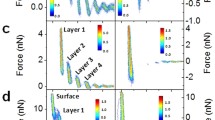3
N4 atomic force microscope (AFM) tip and the surfaces. By increasing the pH of the solution around the isoelectric point (IEP) of Si3N4 of approximately 6, the charge on the Si3N4 AFM tip was changed from positive to negative. The surface charges of the samples were also controlled by the pH of the solution in which the sample oxides were dipped. When the samples were electronically conductive, the surface charge was controlled by the electrode potentials. When the sample surface was heterogeneous in terms of the isoelectric point or point of zero charge (pzc), the surface charge was changed from one place to the other. As a heterogeneous oxide sample, a quartz plate patterned with alumina was used. The lateral charge distributions on such surfaces were mapped by pulsed-force-mode AFM. The lateral resolution of the present method was found to be approximately 20 nm.
Similar content being viewed by others
Author information
Authors and Affiliations
Additional information
Received: 25 July 1997/Accepted: 1 October 1997
Rights and permissions
About this article
Cite this article
Miyatani, T., Okamoto, S., Rosa, A. et al. Surface charge mapping of solid surfaces in water by pulsed-force-mode atomic force microscopy . Appl Phys A 66 (Suppl 1), S349–S352 (1998). https://doi.org/10.1007/s003390051161
Issue Date:
DOI: https://doi.org/10.1007/s003390051161




